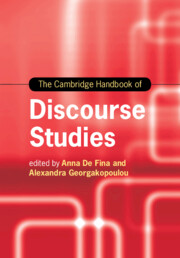Book contents
- The Cambridge Handbook of Discourse Studies
- Cambridge Handbooks in Language and Linguistics
- The Cambridge Handbook of Discourse Studies
- Copyright page
- Contents
- Figures
- Tables
- Contributors
- Preface
- Part I (Con)Textualizing Discourses
- 1 Registers, Styles, Indexicality
- 2 Situating Discourse Analysis in Ethnographic and Sociopolitical Context
- 3 Context and Its Complications
- 4 Historicity, Interdiscursivity and Intertextuality in Discourse Studies
- 5 Rethinking Narrative: Tellers, Tales and Identities in Contemporary Worlds
- Part II Perspectives and Modes of Analysis
- Part III Discourse Materialities and Embodiment
- Part IV (Trans)Locations and Intersections
- Part V Ethics, Inequality and Inclusion
- Part VI Discourses, Publics and Mediatization
- Index
- References
1 - Registers, Styles, Indexicality
from Part I - (Con)Textualizing Discourses
Published online by Cambridge University Press: 28 September 2020
- The Cambridge Handbook of Discourse Studies
- Cambridge Handbooks in Language and Linguistics
- The Cambridge Handbook of Discourse Studies
- Copyright page
- Contents
- Figures
- Tables
- Contributors
- Preface
- Part I (Con)Textualizing Discourses
- 1 Registers, Styles, Indexicality
- 2 Situating Discourse Analysis in Ethnographic and Sociopolitical Context
- 3 Context and Its Complications
- 4 Historicity, Interdiscursivity and Intertextuality in Discourse Studies
- 5 Rethinking Narrative: Tellers, Tales and Identities in Contemporary Worlds
- Part II Perspectives and Modes of Analysis
- Part III Discourse Materialities and Embodiment
- Part IV (Trans)Locations and Intersections
- Part V Ethics, Inequality and Inclusion
- Part VI Discourses, Publics and Mediatization
- Index
- References
Summary
Researchers in linguistic anthropology and post-variationist sociolinguistics have over recent decades increasingly converged on a shared focus of attention: the unfolding real-time process of communicative activities that involve language – spoken/heard, written, digitally mediated – in concert with the other semiotic affordances that provide participants with the means to presume upon, and to (re)create, the very contexts in which forms of talk take place, with various effects in the here-and-now and beyond. Sociolinguists emerging from the confines of variationism have increasingly abandoned the operationalism and quasi-experimentalism of earlier work in favor of more ethnographically rich accounts that take note of the way that facts about sociophonetic variation not only reflect but also help to constitute identities also made manifest in other ways: through styles of dress, bodily practices, consumption patterns, etc. – a set of facts and interpretations often grouped by sociolinguists under the heading of “style.” Linguistic anthropologists, meanwhile, have been increasingly oriented to the way in which observed variation in language usage resolves itself into verbal (phonological, lexical, etc.) repertoires keyed to the interactional contours of recurring types of situation with recurring types of participant role – termed “registers.” Linguistic anthropologists have also been alert to the ways in which linguistic and semiotic resources that are by degrees regularized and presumed “normal” in some contexts (hence, “enregistered”) are, by that very fact, ripe for creative “recycling” and reuse in other contexts, with different effects. All of these disciplinary and transdisciplinary re-alignments, I argue, result from the introduction of a single centrally important analytic concept: indexicality. Introduced into modern linguistics by Jakobson and developed further by Jakobson’s student Silverstein, the concept of indexicality has enabled the recent co-alignment of erstwhile disciplinary forms of inquiry in sociolinguistics and linguistic anthropology, and seems to be the fulcrum for much of the work now emerging at the intersection of these and other fields, including applied linguistics.
- Type
- Chapter
- Information
- The Cambridge Handbook of Discourse Studies , pp. 9 - 31Publisher: Cambridge University PressPrint publication year: 2020
References
Primary Sources
Secondary Sources
- 2
- Cited by



